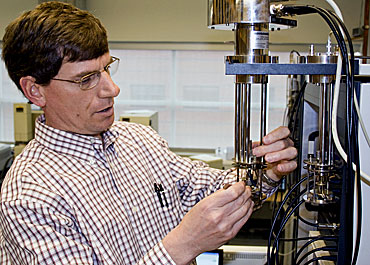 Get Steve Martin going on the science and technology of batteries and he’ll reach for a sheet of graph paper.
Get Steve Martin going on the science and technology of batteries and he’ll reach for a sheet of graph paper.
Martin, an Anson Marston Distinguished Professor in Engineering in Iowa State University’s Department of Materials Science and Engineering and an associate of the U.S. Department of Energy’s Ames Laboratory, will fill that sheet with the chemical formulas of various lithium compounds and materials. He’ll add a few sketches of carbon atoms forming layers of hexagons. He’ll even jot down some lithium-silicon formulas.
It’s his way of explaining the electrochemical reactions that make batteries work and how new materials could be used to make better, safer batteries. And that’s something that could make a big difference for all of us as the world pursues alternatives to fossil fuels.
Just consider the 2,140 wind turbines spinning across Iowa. They’re generating 3,053 megawatts of electricity, making Iowa the second-ranked state in wind power output. Their energy production, of course, varies with the wind. And as long as production of wind energy is relatively small, the existing electricity grid can accommodate the ups and the downs. But, if wind energy climbs above 25 percent of electricity production, Martin said the grid won’t be able to handle the power swings.
“We need to store that extra energy when it’s generated and we’re not using it, like at night,” Martin said. “And so we’re working on electrochemical energy storage mechanisms.”
Martin has several battery projects in the works:
● As part of a Materials World Network, Martin is working to develop better and safer lithium batteries. Network researchers are looking at replacing the liquid electrolyte that separates a battery’s electron-producing anode from its electron-accepting cathode. The liquid electrolyte sometimes fails and catches fire. It also reduces battery power at cold temperatures.
Martin and his collaborators are looking at a solid electrolyte made of glass. Martin’s role in the project is to prepare various glasses and study their structures and conductivity.
The network’s project is supported by a $1 million grant from the National Science Foundation.
● Martin is also collaborating with Iver Anderson, a senior metallurgist for the Ames Laboratory and an adjunct professor of materials science and engineering, and Emma White, a graduate student in materials science and engineering, to develop new materials for a battery’s electron-producing anode.
Rather than using lithium and carbon, they’re studying how lithium-silicon compounds could be used. A lithium-silicon battery could hold a lot more charge, but so far the silicon anode material expands to sizes that are impractical.
“I get excited about this,” Martin said. “The problem isn’t the chemistry. It’s can we create new structures or types of lithium-silicon phases so when the lithium comes in, the volume of the anode doesn’t change?”
The project is supported by a seed grant of $50,000 from the Ames Laboratory.
Martin’s interest in the world’s energy problems goes back to the 1979 oil crisis. He was just graduating from college at the time and took note of the long lines at gas stations and the calls for energy efficiency and conservation. That got him thinking about alternatives to imported oil. And that led him to study the electrochemistry of glass and begin his own research program at Iowa State in 1986.
He’s been working with researchers around the world ever since. And Martin is confident that engineers and scientists doing fundamental research to characterize and understand materials will find ways to make better batteries for a cleaner energy future.
“We will solve these problems – we have to,” he said. “Probably in my lifetime, we’ll have major discoveries that will start to steer us away from burning fossil fuels.”
RadioIowa also carried a story on Martin’s battery research, as did Business Record.